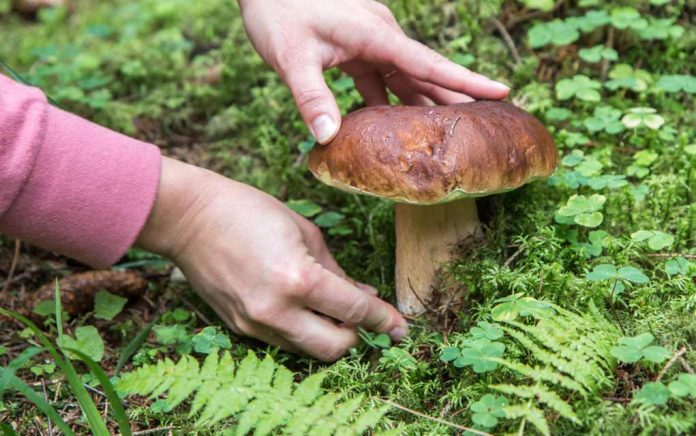(SurvivalDaily.com) – Mushrooms may not seem all that appealing to some people, but in a pinch, they’re enough nutrition to survive on for at least a short period of time. They can also help add flavor to other foods, such as meats or soups. You don’t necessarily need to pay money for them, either; they grow freely in the natural world all around you, including your own backyard! Still, foraging for mushrooms can be dangerous (even deadly) if you don’t know what you’re looking for.
Getting Help
Not everyone learns well from books and pictures. In fact, even if that is your personal learning style, it’s still wise to seek training from a professional. This will allow you to learn from others with more experience identifying mushrooms without taking unnecessary risks with your health. Do not, in any circumstances, eat a fungus you aren’t sure of.
If you can’t join a mushroom club or get an expert to come to identify a mushroom, don’t be afraid to take the mushroom to the expert. If you happen to have a natural history museum nearby, they might even have someone on staff who can identify the fungus for you.
Do note that picking a mushroom is not the same as picking a flower. A mushroom is the fruit of a complex body of vegetative fibers. It is to the ground what an orange is to a tree. In most cases, you should cut the stem cleanly at least a short distance above the ground; this will allow the mushroom to regrow.
Eating Mushrooms
Raw mushrooms might sound kind of questionable, but they’re often found in most salads for a reason. Depending on the fungus among us (yes, that’s a pun), they may have a pleasant, slightly sweet flavor, or they may be more earthy. Most have a slightly spongy texture, but some may be softer than others.
It is recommended that you cook mushrooms to help your body digest them easier. Before cooking, all you need to do is wipe the excess dirt off. Mushrooms are like sponges and can retain water rather quickly; of course, a quick rinse is fine but don’t soak them.
Which Varieties to Eat?
There’s a common saying that, “every mushroom is edible at least once.” That’s a reference to the fact that some are downright toxic or deadly when eaten, which is why you need to be so careful about what you forage.
Of those that are edible, some species are known to be tastier than others. They all contain more protein than the average vegetable.
Chicken of the Woods
Chicken of the Woods (Laetiporus) is a firm orange and yellow mushroom that’s said to stand out like a neon sign. This makes it ideal for beginning foragers. Found during the summer and fall, these usually grow on standing trees or fallen logs (both dead and alive).
This mushroom’s bright colors will catch your eye, but to confirm its identity, check the underbelly. It should be covered in pores, rather than gills. It can be substituted for chicken in most recipes, and carries a similar flavor — hence the name.
Note that it is extremely important to know which specific species of this mushroom you are picking. Some are slightly toxic, and may produce stomach upset or other uncomfortable symptoms. One way to avoid them is to avoid picking mushrooms that grow on softwood trees like conifers or eucalyptus.
Hen of the Woods
Not to be confused with Chicken of the Woods, Hen of the Woods (Grifola frondosa) isn’t even in the same mushroom family, despite the name. Also known as maitake, this large mushroom is made up of lobes that fan out from a central core. You’ll find this fungus growing at the base of live oak trees. It is easily identified by a porous underbelly and wavy brown upper portions, resembling the tail of a hen.
What to Avoid
Death caps/death angels (Amanita phalloides), as the name suggests, are in fact fatal when ingested. The name comes from the fact that, of the mushroom related deaths in the US, this variety is involved 90 to 95 percent of the time.
Death caps are not native to North America; they were introduced and now thrive on the West Coast. This is the number one mushroom involved in fatalities.
Death angels are native to North America, and multiple species share the name “death angel.” Not every variety is immediately toxic, but for some, a single cap is enough to deliver a lethal dose of toxins. Thankfully, these are easily identified by volvas and white spore prints; occasionally they have warts and stem rings.
While not very common, false morels have caused 20 cases of poisoning since 1900 in the US; however, 50% of those ended in a fatality. Found nearly everywhere in the United States, they usually grow during the spring.
Unlike a true morel, false morels have a cap that resembles a crushed or wrinkled brain on a stalk. Slicing the mushroom open from top to bottom or vice versa will reveal the insides. A true morel will be hollow inside, whereas a false morel has a cotton-like texture.
Just like anything else people forage from the great outdoors, you must do your research before you ingest anything. In fact, you shouldn’t even rely on the information we’ve provided here to decide whether something is safe. Don’t become a statistic, especially when it’s easy to avoid. Expand your knowledge slowly, get to know the mushroom kingdom, and if you’re ever in doubt, stick to foods you know instead.
~Copyright 2021, SurvivalDaily.com

















